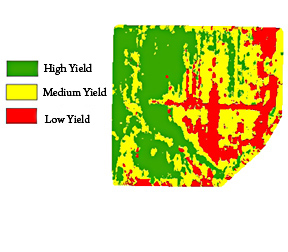This page has been archived and is being provided for reference purposes only. The page is no longer being updated, and therefore, links on the page may be invalid.
|
|
|
|
ARS Study Helps Farmers Make Best Use of Fertilizers
By Don ComisJune 9, 2010
A new way to make topographic maps with radar can help farmers divert more of their resources to the highest-yielding parts of their fields, according to an Agricultural Research Service (ARS) scientist.
James McKinion, an electronics engineer at the ARS Genetics and Precision Agriculture Research Unit at Mississippi State, Miss., did the study with entomologist Jeff Willers and geneticist Johnie Jenkins at the ARS unit in Mississippi.
With the maps fed into computerized, variable-rate fertilizer applicators, precision farmers can divert more of their costly fertilizer to the highest-yielding zones and the least to the lowest-yielding zones. They can also use the zone maps to make other decisions, such as planting more drought-tolerant varieties in low-yield zones, or sowing less seed.
Five years of comparisons between these maps and actual "on-the-go" yield monitoring for cotton and corn on a farm in Mississippi showed that accurate yield predictions can be made based on topography.
The researchers contracted to have a plane with LIDAR (light detection and ranging) sensors fly over the 1,000 rolling acres of the farm. LIDAR is a form of radar that can map elevations digitally, showing slopes and sun exposures, by bouncing laser light off the landscape.
By blending yield results with the maps, the scientists divided fields into high-, medium-, and low-yield zones.
One advantage of LIDAR landscape mapping is that it only has to be done once.
LIDAR topographic mapping is spreading from state to state. Louisiana, for example, has financed LIDAR mapping of the entire state.
Otherwise, it is expensive for an individual farmer to pay for LIDAR mapping. So, McKinion is also looking for alternative topographic mapping techniques.
This research was published in Computers and Electronics in Agriculture.
ARS is the principal intramural scientific research agency of the U.S. Department of Agriculture (USDA). This research supports the USDA priority of promoting international food security.

